Big mountain. Fun ride. Great view. Ready to go eat?
“What do you want to do now?” Marcelo asked us.
“Uhhh,” we all replied. “Is the Botanical Gardens open?” Jean asked.
“I don’t think so,” Marcelo replied. “It is still Carnaval.”
“What about Sugarloaf?” I asked. I had seen the cars going up there, so figured it was open. And surely it had a bathroom.
“Ees very close,” Marcelo replied, sealing the deal.
 When we pulled up in the parking lot, there was a line that stretched down the steps to the ticket booths and around the perimeter. It looked long at first, but seemed to be moving fairly rapidly. What else were we gonna do? Ride around looking for something that had a shorter line? I don’t think so. We decided to gut it out.
When we pulled up in the parking lot, there was a line that stretched down the steps to the ticket booths and around the perimeter. It looked long at first, but seemed to be moving fairly rapidly. What else were we gonna do? Ride around looking for something that had a shorter line? I don’t think so. We decided to gut it out.
I remember one trip Jean and I took with the boys to Magic Mountain in California. Roller coaster heaven! I was about to hyperventilate with expectation until I saw all the lines. So what did we do? Stand in each line for about 10 minutes, get antsy, then go try to find a shorter line. Which we never did. And we wasted a couple of good hours on this ridiculous maneuver. We finally settled down and stood in a few lines, and actually got to ride four big coasters that day. I hate crowds and lines. I also love theme parks. It’s like crushing the shell into the pecan meat. You have to pick it all apart gradually, separating out the shell, to get any meat. Or a plate of boiled crabs. It’s all a lot of work for a little pleasure.
We asked Marcelo if he wanted to come with us, but he said no, he’d stay in the car and read or go get something to eat. “Okay, we’ll meet you out here when we’re through, okay?” Jean was asking, as I hauled ass up the stairs to find the sanitário.
 “I’ll meet y’all at the end of the line,” I hollered at them, noticing that Robo was coming up behind me. Inside the building I was met with various wall displays and a diorama of Rio, the bay and the various mountains that rise from it. There was a tiny little cable car mounting a tiny little Sugarloaf. Neat. There was also a gift shop, but it became a blur as I dashed past and up the stairs as fast as one like me can dash. Robo must have ridden my draft, because we appeared at the door to the sanitário simultaneously, and almost did a Three Stooges trying to get through it together.
“I’ll meet y’all at the end of the line,” I hollered at them, noticing that Robo was coming up behind me. Inside the building I was met with various wall displays and a diorama of Rio, the bay and the various mountains that rise from it. There was a tiny little cable car mounting a tiny little Sugarloaf. Neat. There was also a gift shop, but it became a blur as I dashed past and up the stairs as fast as one like me can dash. Robo must have ridden my draft, because we appeared at the door to the sanitário simultaneously, and almost did a Three Stooges trying to get through it together.
Once we got back to the others, we saw that the line wrapped around by a memorial statue of a WWI or II Brazilian soldier. Maybe Marcelo can tell me who he is. While we were standing in the line, there was a vendor selling these little plastic bikini clad girls that you would clip on the edge of a beer can to make a handle. They were the perfect thing to bring back! I must say, though, it is a rather tacky juxtaposition with the statue.
And of course I began my photo onslaught on Daniel and Patricia with this pic in front of the stricken soldier.
 We marveled at the people scaling the mountain behind the ticket booth. They were at least 100 feet in the air, clinging onto the face of the rock, looking like flies on a dark wall: hard to find at first. Watching them up there caused every orifice on my body to slam shut in fear. But I could hardly look away.
We marveled at the people scaling the mountain behind the ticket booth. They were at least 100 feet in the air, clinging onto the face of the rock, looking like flies on a dark wall: hard to find at first. Watching them up there caused every orifice on my body to slam shut in fear. But I could hardly look away.
The line was indeed fast, and before we knew it, were up at the booth. Robo’s grant had included entertainment expenses for D & P, and this somehow translated into some clusterfuck at the ticket booth that took Patricia’s expertise (read “Portuguese”) to sort out for us. Of course we’d also be the very ones to hold up the line after we had worked that Yoruba curse on the people in front of us. Irony is so funny!
I was a tad fluttery about the whole thing of course, with the curse going awry, and my being so terrified of unsecured heights. In a machine or building I’m usually fine, but I have a special subsection in my book of fears for this. An air gondola is neither fish nor fowl. It’s a machine, but it’s on a stupid two inch cable. And there are 75 people in this thing supported by this long-ass wire that runs up to one huge mountain, stops, then goes up another slacky wire to Sugarloaf, 1299 feet above sea level.
So what do I do? As the car begins to magically, impossibly, lurch up to the first mountain, I say casually to Jean, “Look honey, we’re over all those trees. If the cable snaps they’ll be there to break our fall.”
“Stop that!” she hissed at me. Then we both started laughing nervously.
At this point, I had to ponder Robo and Pettus’ desire to hang glide while we were in Rio. Neither had ever done it or anything like it, and it sounded like fun to them. They had even asked Sylvia to look into it for them. Unfortunately, with the foggy weather we were still having, it was out of the question at the time. But there went my orifices again anyway, from just thinking about it.
We got to stage one quickly, disembarked easily, and began to gawk at the view. Though cloud-studded, it was still beautiful. I seemed to take a ton of pictures of The Christ through the haze, and some of them are pretty spiffy.
 On the first level, there were benches everywhere, and people were lounging around like it was a park or something. I took a shot of the group, then Robo took one of Jean and me.
On the first level, there were benches everywhere, and people were lounging around like it was a park or something. I took a shot of the group, then Robo took one of Jean and me.

 It’s totally amazing how much Jean looks like her mother.
It’s totally amazing how much Jean looks like her mother.
Here’s another good shot of The Christ from this level
It was time to try to beat the rush to the tram up to Sugarloaf. Due to construction we had to follow a convoluted course over boards on scaffolding (fun) until we finally turned the corner to the next station. Here are a couple of cool shots of the convex mirror, the people in it, and the big mountain right behind.

 In this closeup, it looks like Robo is pissed off about something. This could be the point in the trip where his sinuses began to revolt against him. The altitude may have been punching him in the forehead.
In this closeup, it looks like Robo is pissed off about something. This could be the point in the trip where his sinuses began to revolt against him. The altitude may have been punching him in the forehead.
 Once we had alighted the car, we were instantly hit with the unobstructed panorama that Sugarloaf affords. These shots of the harbor were very cool. Notice how the orange roofs of the chi-chi enclave below echo the favelas. Both ends of the money spectrum with similar visual impact. EYE ROW KNEE!
Once we had alighted the car, we were instantly hit with the unobstructed panorama that Sugarloaf affords. These shots of the harbor were very cool. Notice how the orange roofs of the chi-chi enclave below echo the favelas. Both ends of the money spectrum with similar visual impact. EYE ROW KNEE!

 By this time, Daniel was hungry again. The grant included snacks, too! Robo handed him a bunch of Reais, and we walked up to the booth to order. I got a couple of agua com gaís (sparkling water), and then discovered that they had those cheese roll things! Daniel ordered that and a Coke. We all sat around, Daniel politely sharing his food, the rest of us like a bunch of dive bombers into the little paper tray. I chugged that agua com gaís pretty fast, then decided to go take another picture of The Christ ruling over Rio.
By this time, Daniel was hungry again. The grant included snacks, too! Robo handed him a bunch of Reais, and we walked up to the booth to order. I got a couple of agua com gaís (sparkling water), and then discovered that they had those cheese roll things! Daniel ordered that and a Coke. We all sat around, Daniel politely sharing his food, the rest of us like a bunch of dive bombers into the little paper tray. I chugged that agua com gaís pretty fast, then decided to go take another picture of The Christ ruling over Rio.
 I also spent time taking pictures of other people with their cameras. There were a bunch of Australians there, and I did shots of 3 different Aussie couples.
I also spent time taking pictures of other people with their cameras. There were a bunch of Australians there, and I did shots of 3 different Aussie couples.
The others were ready to go, and sent Daniel looking for me. “We’re ready to go,” he said “Are you?”
“Sure. I don’t think the view is gonna change.”
We saw a bunch of people heading for the tram station, so we hustled as fast as we could to beat them there without looking like we were trying to beat them there. That’s called “manners.”
Once inside, I took this shot of the group despite their protests. They all warned me that if we missed that tram they would kill me. Amazing they can look so pleasant and yet be so threatening.
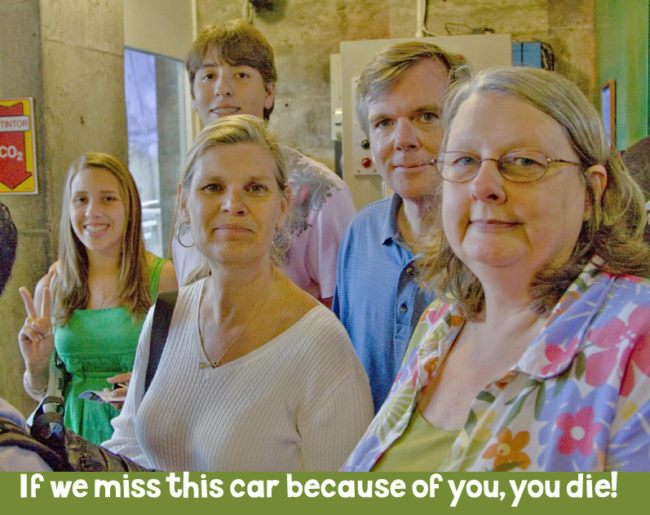 We made the car without any trouble. But there was a counter that told how many could get on, and it was ticking madly toward the limit. And a few extra I noted, to my chagrin.
We made the car without any trouble. But there was a counter that told how many could get on, and it was ticking madly toward the limit. And a few extra I noted, to my chagrin.
In order to divert herself, Jean began listening in on other conversations. There were enough English speakers there to have a little field day, and get her internal radio working again. She noticed a young American guy wearing an Ole Miss hat. He was with an Australian guy. Once we had gotten to the first station, she knew enough about him to say to him on the way out, “Are you from Mississippi?”
“Yes ma’am!” he said politely and enthusiastically. “How did you know?”
“Well first, your accent. And you have “Rebels” on the back of your hat. It was kind of a no-brainer.”
This brought on an advanced session of the “Do You Know? Game”. I believe he did know one of the Lee twins from Ole Miss, and had a bunch of friends that live in Mountain Brook that would know Frank’s friends from there. Ahh. Satisfying. That’s one of the beauties of being from the South. You can play “the game” for less than five minutes and have three connections. But to play it on level one of the Sugarloaf Experience was just pretty bizarre.
While they worked on the Rebel connections tapestry, I shot a couple of pictures of the gears and a beautiful hybiscus.
 It turns out that the guy was here in Brazil on kind of an exploration trip. He had been to Argentina looking to buy property to set up a winery/fine restaurant/lodge and hunting deal for executives and jet setters. Being from the South, he was completely familiar with the hunting part. Having money, which he obviously did, would give him an edge with clientele.
It turns out that the guy was here in Brazil on kind of an exploration trip. He had been to Argentina looking to buy property to set up a winery/fine restaurant/lodge and hunting deal for executives and jet setters. Being from the South, he was completely familiar with the hunting part. Having money, which he obviously did, would give him an edge with clientele.
He was with an Australian guy he had met at one of the hostels he had stayed in. So he was possibly short on money. But he was used to it, you could tell. Maybe just had a pedigree and not so much money now. I don’t know, but I kind of doubt it. He wielded the mantle of breeding easily, being pleasant, expansive, attentive to the girls and Patricia in particular, and willing to spend a little time with some fellow Southerners. His Aussie companion was also pleasant, but seemed completely disconnected with the conversation, especially when the young guy began to lapse into a definitive Mississippi drawl right before his eyes.
And don’t think for a minute that Mama Jean wasn’t trying to hook him up with Patricia. He had to promise that he would contact her if he came through Salvador on his travels before she would let him go. The thing is, I believed him when he said that he would.
 None of us passed up the bathroom when we landed, and I got a chance to see a little more of what was in the gift shop. I’ll be switched if there weren’t several statues of Iemanjá on the shelf! I could tell because she was admiring herself in the mirror, and there were shells all around her. But only one who had felt her hot breath on his neck would recognize her with such clarity.
None of us passed up the bathroom when we landed, and I got a chance to see a little more of what was in the gift shop. I’ll be switched if there weren’t several statues of Iemanjá on the shelf! I could tell because she was admiring herself in the mirror, and there were shells all around her. But only one who had felt her hot breath on his neck would recognize her with such clarity.
I rushed outside, only glancing at the diorama as I zoomed past. Fortunately, there was Marcelo waiting on us, to break the spell. I jumped in and took off my Crocs immediately, stuffing another water bottle into the side pockets on the door. I had quite a collection of half-drunk bottles going.
“Did you go eat?” I asked him.
“No. I read in the car,” he replied.
“Well I know for sure that I’m hungry, and I’m sure the rest of them will be by the time we get back home, so let’s go eat, okay? Surely y’all want to eat soon, don’t you?” I asked them.
“Duh!” was the response.
“Of course, then,” Marcelo said. “There are many good places.”
“Well, I want one that will give me some food,” I told him. “But it can’t be too fancy if we’re not going home to change.”
“I know a place,” he assured me.
I relaxed, knowing that my newly interested belly was gonna get some attention.
As we headed over the bridge to Niterói and passed one of the impotent cranes, I had a sudden revival of my earlier laughing fit. But only enough to wake me up a little. Not a full blown attack.
The way home (and yes, Mirante de São Francisco felt like home, especially now that D&P were there with us) had become familiar, and there were several ways to get there ultimately, but they were all scenic. Once you had crossed under the toll booths, the roads began to feel narrower and more random than in Rio proper. Sometimes we’d go by the Niedermeyer-designed art museum, other times not. I guess it depended on whatever mood Marcelo was in.
We drove along restaurant row, passing Paludo, and Porcão, which prompted Marcelo to remark, “There you can eat when you have time and want it to be very nice. When you eat there, it is a party.” We all took note that Porcão was at the top of the food chain.
“La Verdanna,” Marcelo said, as he pulled into the portico. “Ees very good. Meats brought to your table.”
That was all any of us wanted to hear as we began to pile out. “You’re going to eat with us, aren’t you?” I asked.
“Yes, thank you,” Marcelo replied.
 Jean loves having that ole picture made, doesn’t she?
Jean loves having that ole picture made, doesn’t she?
La Verdanna was one of those places where the servers come by with skewers of all kinds of different meat. You are given a little card that has a green side reading “Sim” and a red side reading “Não”. If the green side is up, the guys keep coming by.
I think Marcelo knew some people there, because they seemed to buzz around us extra. Right out of the chute they came up with sausage on a skewer, filet, filet with garlic, roasted bananas, manioc flour, lobster puffs, French fries (Daniel got some), and three or four other things. I was saying “Sim” to everything, and before long, had a plateful of stuff.
They also brought out chicken hearts stacked neatly on a skewer. They really did look like little hearts. Daniel ate half the ones in the restaurant in addition to everything else they brought by. He was a marvelous, magical eating machine! Oddly enough, I was already starting to get a little full from the rapid onslaught of skewer-to-plate-to-mouth that hits you the second you sit down, and the thought of the coraçãoes da frango kind of reminded me of stomach surfing in Salvador. So I politely flashed a “Não.”
Marcelo said “Don’t forget to try the food over there,” pointing to an elaborate buffet like the one at Paludo.
“Whaa??” I asked. “Is that included?”
“Yes,” he said. “Ees very good.”
I took his picture as a reward for this information.
 Look at that noble face! A native Niteróian, just like Sergio Mendes! What’s not to love? Right in the middle of my waxing philosophic about Marcelo and his importance, he interrupted with “What about my image rights for the picture? Are you going to pay me image rights?” I responded with a big laugh, and then another picture. This time Daniel sniffed out the camera, joining the exclusive club that Robo and I are members of.
Look at that noble face! A native Niteróian, just like Sergio Mendes! What’s not to love? Right in the middle of my waxing philosophic about Marcelo and his importance, he interrupted with “What about my image rights for the picture? Are you going to pay me image rights?” I responded with a big laugh, and then another picture. This time Daniel sniffed out the camera, joining the exclusive club that Robo and I are members of.
 Looks like one of them gol-durned Jonas Brothers, doesn’t he? If he didn’t have that zit, he could be a star.
Looks like one of them gol-durned Jonas Brothers, doesn’t he? If he didn’t have that zit, he could be a star.
This next shot is funny, especially if you know Pettus. Every now and then she gets this look, especially if Robo is hammering her with some kind of information. I never have been able to tell if she is actually taking anything in, or is just mentally going, “La la la la la la la la.”
 Despite the mass of food, we all decided to share a dessert. And managed to eat it all.
Despite the mass of food, we all decided to share a dessert. And managed to eat it all.
 We headed out, all about to bust. I obrigado’ed the shit out of everybody, and so did Jean. “It’s obrigadA,” I told her on the way out. “You said obrigadO.”
We headed out, all about to bust. I obrigado’ed the shit out of everybody, and so did Jean. “It’s obrigadA,” I told her on the way out. “You said obrigadO.”
“Yeah?” she answered.
“Well, I’m so much cooler than you.”
“Yeah?” she answered.
I responded by making them line up for a picture.
 And then, just to make sure I wasn’t a total idiot about my hatred of flash, one with the flash.
And then, just to make sure I wasn’t a total idiot about my hatred of flash, one with the flash.
I am right to hate it. And so is Pettus.
 The valet pulled up with Marcelo’s car, and we all wedged ourselves in and headed home, which was by now a familiar thing.
The valet pulled up with Marcelo’s car, and we all wedged ourselves in and headed home, which was by now a familiar thing.
When we were getting out of the car, Jean asked Marcelo, “Can you take us out tomorrow?” expecting an answer of “Yes, but you must call Sylvia.”
“No, I can’t,” Marcelo said. “I have someone else I have to pick up.” Inside my head, I heard the sound of screeching brakes.
“WHAT?” I blurted out? “What do you mean ‘have someone else to pick up’?”
“Yes, I’m sorry,” Marcelo said.
“Well what will we do?” I pleaded.
“There are a lot of cabs, and the ferry is good to get to Rio,” he said.
“We’ll try that,” the others said.
“Okay then,” I pouted. “I hope you have a great time with your new little friends.”
Marcelo laughed and said, “You will be fine. I will see you the next day.”
“You better,” we all said, getting the gate code right the first time and trudging in to watch Brazilian TV and plan the next day without The Man.

 Good googly GOOT! The place was packed! And everything was wet from a recent shower. At least we weren’t there for that. We surveyed the situation, and finally found a spot, of course halfway down an aisle. Pettus led, followed by Robo, Jean and then me. I was the caboose powered by a poor rendition of liçensa, a shortening of the expression for “excuse me.” Nobody seemed particularly bothered by us, and many returned my expectant smile immediately.
Good googly GOOT! The place was packed! And everything was wet from a recent shower. At least we weren’t there for that. We surveyed the situation, and finally found a spot, of course halfway down an aisle. Pettus led, followed by Robo, Jean and then me. I was the caboose powered by a poor rendition of liçensa, a shortening of the expression for “excuse me.” Nobody seemed particularly bothered by us, and many returned my expectant smile immediately. Unidos da Tijuca (referred to as Tijuca) was coming slowly from our right. The first thing we saw, besides the blue and yellow flags that we were frantically waving, was a gigantic blue and gold peacock who would furl and unfurl its wings in time to the music that I hadn’t caught onto yet, blaring tastefully and pleasingly from the speakers that lined the runway. Nice, we all thought. What kind of motor would that take, Robo and I wondered. And then we discovered that the peacock’s epidermis was homo sapiens, and its feathers were controlled by same. Meu Deus!
Unidos da Tijuca (referred to as Tijuca) was coming slowly from our right. The first thing we saw, besides the blue and yellow flags that we were frantically waving, was a gigantic blue and gold peacock who would furl and unfurl its wings in time to the music that I hadn’t caught onto yet, blaring tastefully and pleasingly from the speakers that lined the runway. Nice, we all thought. What kind of motor would that take, Robo and I wondered. And then we discovered that the peacock’s epidermis was homo sapiens, and its feathers were controlled by same. Meu Deus!



 Notice the people hanging out of the camarotes. They’re the private boxes that you can buy a regular old ticket for, or come to party with one of the several companies, etc. that rent them for the event. Also notice the furry blue bears and the closeup that follows: cutout belly and vents galore.
Notice the people hanging out of the camarotes. They’re the private boxes that you can buy a regular old ticket for, or come to party with one of the several companies, etc. that rent them for the event. Also notice the furry blue bears and the closeup that follows: cutout belly and vents galore.



 But then they’d throw in this dash of Rowrrrrr with the genie girls, and it would balance out into some kind of Twin Peaks fantasy.
But then they’d throw in this dash of Rowrrrrr with the genie girls, and it would balance out into some kind of Twin Peaks fantasy. The way these parades worked is, they would intersperse the basic elements: floats, highly trained participants, lightly trained participants, percussion sections, samba steppers only, movie and TV stars in duos as flag couples, and movie and TV stars solo and in tiny costumes like they should be. There is a rule against any genital nudity, and a g-string is required for all hotties. The stars would have their own performing areas, and were like little dabs of rich chocolate on a dessert. The choreographers spaced everything perfectly. The blue bears you saw above were one-time samba steppers. The guy in the big hoop skirt was probably a part-timer, and the dolls doing the big gig in the dollhouse were surely full-timers. But what do I know, really?
The way these parades worked is, they would intersperse the basic elements: floats, highly trained participants, lightly trained participants, percussion sections, samba steppers only, movie and TV stars in duos as flag couples, and movie and TV stars solo and in tiny costumes like they should be. There is a rule against any genital nudity, and a g-string is required for all hotties. The stars would have their own performing areas, and were like little dabs of rich chocolate on a dessert. The choreographers spaced everything perfectly. The blue bears you saw above were one-time samba steppers. The guy in the big hoop skirt was probably a part-timer, and the dolls doing the big gig in the dollhouse were surely full-timers. But what do I know, really?
 This was followed by two 25 foot tall, bald, topless fairies. Fantastic bodies, but glitter for hair, and slightly menacing expressions. Compare their size to the operator on the ground and the people gawking from the camarotes. On the heels of the dollhouse, this was also visually thrilling and unsettling. The giant multicolored pixies were moving up and down in time to the music as well, due to the people on the float producing sympathetic vibrations, but in other cases from a hidden operator inside. I was beginning to feel the vibe of the Rio designers, and how it compared with Carnival that I’m familiar with in Mobile and New Orleans: gaudy, wild, scary, funny, mysterious, otherworldly. But Rio had them beat, hands down. This was serious, fun and fantastic entertainment.
This was followed by two 25 foot tall, bald, topless fairies. Fantastic bodies, but glitter for hair, and slightly menacing expressions. Compare their size to the operator on the ground and the people gawking from the camarotes. On the heels of the dollhouse, this was also visually thrilling and unsettling. The giant multicolored pixies were moving up and down in time to the music as well, due to the people on the float producing sympathetic vibrations, but in other cases from a hidden operator inside. I was beginning to feel the vibe of the Rio designers, and how it compared with Carnival that I’m familiar with in Mobile and New Orleans: gaudy, wild, scary, funny, mysterious, otherworldly. But Rio had them beat, hands down. This was serious, fun and fantastic entertainment.
 The next float was populated by sexy girls, guys in top hat and tails, and a chandelier with human candles. I believe this float represented time, or elegant furnishings, one. I don’t believe I could keep up the payments on THAT kind of light fixture.
The next float was populated by sexy girls, guys in top hat and tails, and a chandelier with human candles. I believe this float represented time, or elegant furnishings, one. I don’t believe I could keep up the payments on THAT kind of light fixture.

 Speaking of extinction, next came my favorite bunch of samba steppers in the Tijuca show, and probably the whole thing: the dinosaur guys! Their bony heads and tails produced a delightful synchronized wiggling with the music that was funny and mesmerizing.
Speaking of extinction, next came my favorite bunch of samba steppers in the Tijuca show, and probably the whole thing: the dinosaur guys! Their bony heads and tails produced a delightful synchronized wiggling with the music that was funny and mesmerizing.

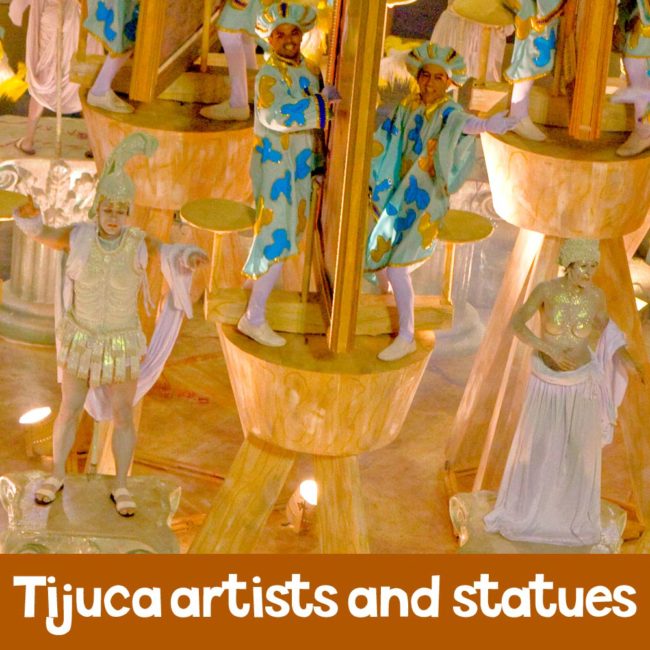
 All of Tijuca’s blinding excess came to an end just as all the schools did: with the cleanup crew. I couldn’t help but flash to the end of “Peabody’s Improbable History” on the
All of Tijuca’s blinding excess came to an end just as all the schools did: with the cleanup crew. I couldn’t help but flash to the end of “Peabody’s Improbable History” on the  It was at this point when Robo paused his video camera, turned to us, and said in a tone dry as sand, “I’ve seen better.” I thought I was gonna fall off the bleachers. But our new friends, somehow having no trouble understanding what was said, completely missed the hilarity of the understatement. They whipped around to look at Robo with faces that were very easy to read.
It was at this point when Robo paused his video camera, turned to us, and said in a tone dry as sand, “I’ve seen better.” I thought I was gonna fall off the bleachers. But our new friends, somehow having no trouble understanding what was said, completely missed the hilarity of the understatement. They whipped around to look at Robo with faces that were very easy to read. The guy’s sister sitting next to me was Flávia Rios, a lawyer from Rio. She was ebullient, friendly, and made us all glad we had picked those seats. The friends she had with her were equally pleasant, but she was clearly the ringleader of fun. I tried all the Portuguese on her I had in my bag, and eventually began mixing it with Spanish, which she was more familiar with than English or my mishandling of her verbs and nouns. Around this time, one of the many vendors climbed the bleachers stepping through the crowd like he was dodging land mines. It was amazing. Their balance while holding giant coolers on their shoulders was uncanny. Then being able to park in front of their customers, cooler on a bended knee, while hardly causing a stir at all–it was more than I could take in. Flávia bought us a beer just as the massive explosion of fireworks to our east announced the arrival of Imperatriz.
The guy’s sister sitting next to me was Flávia Rios, a lawyer from Rio. She was ebullient, friendly, and made us all glad we had picked those seats. The friends she had with her were equally pleasant, but she was clearly the ringleader of fun. I tried all the Portuguese on her I had in my bag, and eventually began mixing it with Spanish, which she was more familiar with than English or my mishandling of her verbs and nouns. Around this time, one of the many vendors climbed the bleachers stepping through the crowd like he was dodging land mines. It was amazing. Their balance while holding giant coolers on their shoulders was uncanny. Then being able to park in front of their customers, cooler on a bended knee, while hardly causing a stir at all–it was more than I could take in. Flávia bought us a beer just as the massive explosion of fireworks to our east announced the arrival of Imperatriz.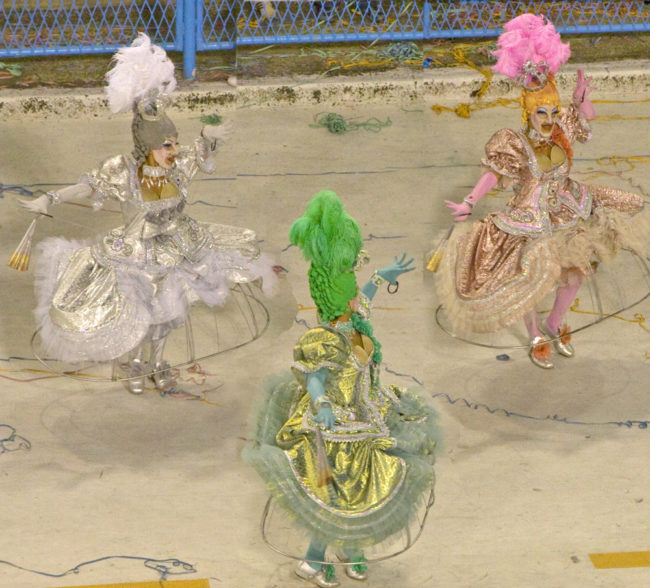 I began to notice more about the parades, like the existence of a gaggle of sideline coaches and conductors. This guy could just as well be working a soccer match, with that pose.
I began to notice more about the parades, like the existence of a gaggle of sideline coaches and conductors. This guy could just as well be working a soccer match, with that pose. I had a hard time figuring out who these next guys were supposed to be. Were they the King and Maria in bedclothes with the beds attached? Were those things mirrors? I had no idea. The picture looks like these folks are kind of panicking because they’re tangled up or something.
I had a hard time figuring out who these next guys were supposed to be. Were they the King and Maria in bedclothes with the beds attached? Were those things mirrors? I had no idea. The picture looks like these folks are kind of panicking because they’re tangled up or something. I wasn’t quite sure what the next two groups were. I think they were fancy men followed by fancy women. Don’t tell me those costumes aren’t hot as hell.
I wasn’t quite sure what the next two groups were. I think they were fancy men followed by fancy women. Don’t tell me those costumes aren’t hot as hell. Flávia told me that the flag couple were stars in Brazil, and that most of the solo hotties were, as well. That was the first I had heard of this phenomenon, but it made sense. It also would help in the competition to have a huge star in your show. There were many elements that made up the judges’ eventual score, and that was just one of them. I read that the performance of these flag-bearing couples can rack up 40 points. It didn’t say out of how many total, but it sounded important nevertheless.
Flávia told me that the flag couple were stars in Brazil, and that most of the solo hotties were, as well. That was the first I had heard of this phenomenon, but it made sense. It also would help in the competition to have a huge star in your show. There were many elements that made up the judges’ eventual score, and that was just one of them. I read that the performance of these flag-bearing couples can rack up 40 points. It didn’t say out of how many total, but it sounded important nevertheless. All of the floats had poles for the riders to hold onto. When everybody starts to samba together on one of those things, the sway is rhythmic and can be rather drastic. Without the poles, they’d be flinging people into the crowd from both sides. I think it would be kind of scary to ride on one, being such a vertiginous sort.
All of the floats had poles for the riders to hold onto. When everybody starts to samba together on one of those things, the sway is rhythmic and can be rather drastic. Without the poles, they’d be flinging people into the crowd from both sides. I think it would be kind of scary to ride on one, being such a vertiginous sort.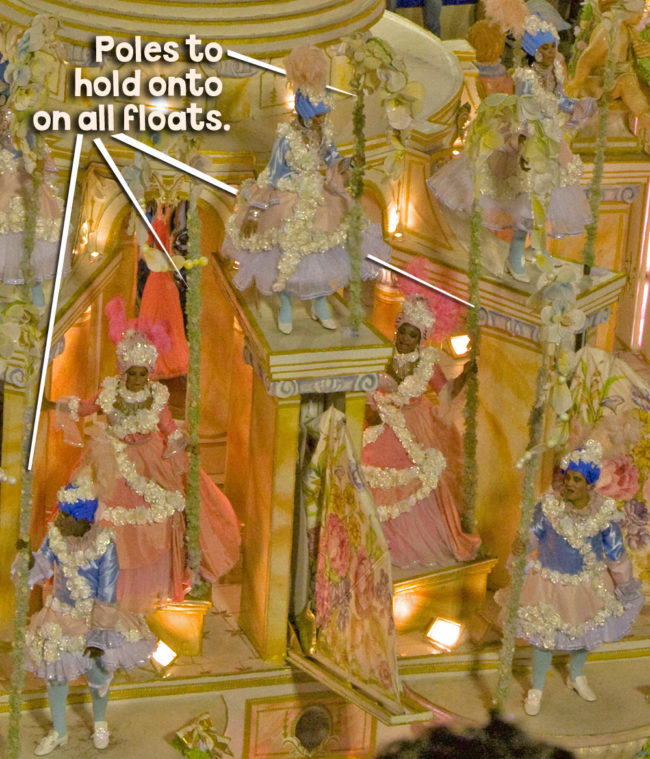 The next float looks like a representation of the French Revolution. Uhh. Yeah. Marie Antoinette and all.
The next float looks like a representation of the French Revolution. Uhh. Yeah. Marie Antoinette and all.

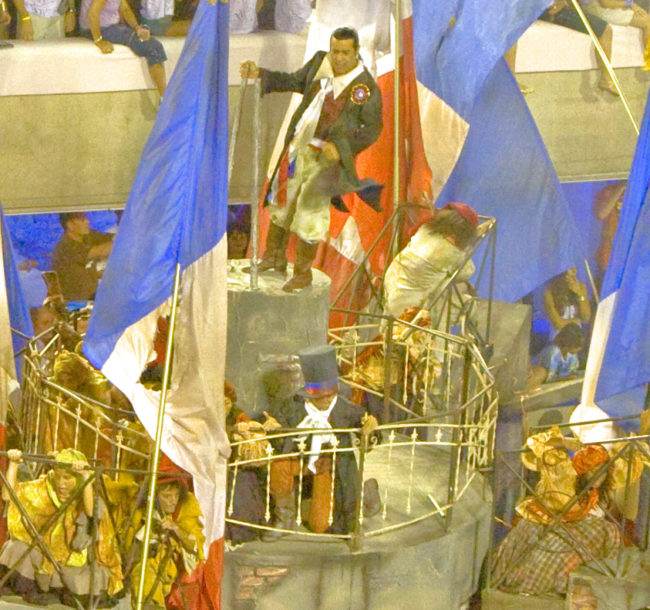 Next came the Brazilian hottie. She was an exotic bird on acid as she pranced her beautiful self around. The picture of the conductor and the single percussion guy looks like he’s telling him not to come yet–the star was still performing in that space. I don’t know, though, he could have been a star in his own right, and doing a little tambourine solo or something.
Next came the Brazilian hottie. She was an exotic bird on acid as she pranced her beautiful self around. The picture of the conductor and the single percussion guy looks like he’s telling him not to come yet–the star was still performing in that space. I don’t know, though, he could have been a star in his own right, and doing a little tambourine solo or something.
 The golden twirlers that followed were so very cool. You can’t tell anything from a still picture, but when all that gold starts rotating at the same time, changing directions like birds in flight, it is mind blowing. Plus, you couldn’t see their arms so well under those enormous costumes. Woo-WEE!
The golden twirlers that followed were so very cool. You can’t tell anything from a still picture, but when all that gold starts rotating at the same time, changing directions like birds in flight, it is mind blowing. Plus, you couldn’t see their arms so well under those enormous costumes. Woo-WEE! The gigantic horses that followed the golden girls were impressive, to say the least. Especially the way they trotted in time to the music. Part sympathetic vibrations, yes, but was somebody moving them? I don’t know if that was true in this case. This float was an eye-popper with two bigwigs on top. I would think the horses would have gotten tired from pulling not only the coach with all those people, but the house as well. The guy in the green jumpsuit looks half like a trainer and half like the guy who is in charge of scooping up giant
The gigantic horses that followed the golden girls were impressive, to say the least. Especially the way they trotted in time to the music. Part sympathetic vibrations, yes, but was somebody moving them? I don’t know if that was true in this case. This float was an eye-popper with two bigwigs on top. I would think the horses would have gotten tired from pulling not only the coach with all those people, but the house as well. The guy in the green jumpsuit looks half like a trainer and half like the guy who is in charge of scooping up giant  Dolphins and parakeets followed the horses. I didn’t know what they represented, but now think they show the King’s passage to Brazil and his discovery of dolphins and parakeets.
Dolphins and parakeets followed the horses. I didn’t know what they represented, but now think they show the King’s passage to Brazil and his discovery of dolphins and parakeets. Following my theory, this next group are the new types of cooks he met in Brazil, and the new foods that he found here.
Following my theory, this next group are the new types of cooks he met in Brazil, and the new foods that he found here.



 The favorite thing found by the King when he came to Brazil was gold. It had already caused all kinds of trouble and resulted in meanness and body parts toted through the city. I wonder if the bankers were the ones who wanted to represent gold.
The favorite thing found by the King when he came to Brazil was gold. It had already caused all kinds of trouble and resulted in meanness and body parts toted through the city. I wonder if the bankers were the ones who wanted to represent gold. It’s fun trying to put my made up Brazilian history with what I think these floats are. Therefore, I will tell you that this next float represents the botanical gardens that were started by King John VI. And yes, after a quickie Google, I find that this was indeed the king that graced the city with one of the most stunning gardens in the world. But I should have known that already, because Marcelo told us all about it when we saw them in all their glory ourselves. Stupid! Stupid! Stupid!
It’s fun trying to put my made up Brazilian history with what I think these floats are. Therefore, I will tell you that this next float represents the botanical gardens that were started by King John VI. And yes, after a quickie Google, I find that this was indeed the king that graced the city with one of the most stunning gardens in the world. But I should have known that already, because Marcelo told us all about it when we saw them in all their glory ourselves. Stupid! Stupid! Stupid!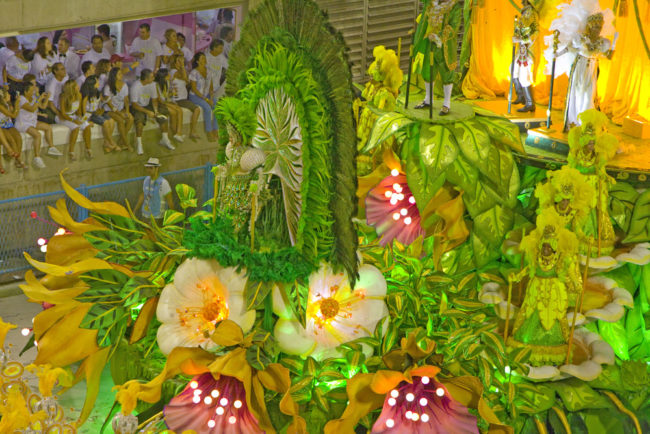

 The last float featured people in weird poodle puff outfits representing what I don’t know. It surely was also peopled with members of the old guard, who had been with Imperatriz for years, or were important to the school. They played big parts on many floats as well, and were sprinkled throughout the performance in key places.
The last float featured people in weird poodle puff outfits representing what I don’t know. It surely was also peopled with members of the old guard, who had been with Imperatriz for years, or were important to the school. They played big parts on many floats as well, and were sprinkled throughout the performance in key places.

 Vila Isabel had exploded in the east with the traditional fireworks, but in tech savvy Rio of the 21st century, every parade was accompanied by the garish flashing of sponsorships on a huge digital screen. For some (smart) reason, they went for maximum overdrive on the flashing, and it blended almost comfortably with the pyrotechnics and the lineup to follow.
Vila Isabel had exploded in the east with the traditional fireworks, but in tech savvy Rio of the 21st century, every parade was accompanied by the garish flashing of sponsorships on a huge digital screen. For some (smart) reason, they went for maximum overdrive on the flashing, and it blended almost comfortably with the pyrotechnics and the lineup to follow. Flávia and I had become real buddies by this time (translated “several beers each”), and she began to tell me about good bars for us to visit in Rio.
Flávia and I had become real buddies by this time (translated “several beers each”), and she began to tell me about good bars for us to visit in Rio. The first big float was a couple of winged horses with fish tails bearing psychedelic compasses. Beautiful, stately and trippy all at the same time, I erroneously dub them “Pegasus.” The glow underneath was like some people put under their cars in blue or purple. I personally love it, though Jean would probably not support an expenditure for such an accessory on my Honda.
The first big float was a couple of winged horses with fish tails bearing psychedelic compasses. Beautiful, stately and trippy all at the same time, I erroneously dub them “Pegasus.” The glow underneath was like some people put under their cars in blue or purple. I personally love it, though Jean would probably not support an expenditure for such an accessory on my Honda. Aha! My first sighting of “the great and powerful Oz” in the belly of Pegasus 1 (or is it 2). And for a flying horse, this nag sure needs a lot of guys to push.
Aha! My first sighting of “the great and powerful Oz” in the belly of Pegasus 1 (or is it 2). And for a flying horse, this nag sure needs a lot of guys to push. Being that I have no inkling what the dual Pegasi had to do with workers in Brazil, I’ll now proceed with a great and valid account of what was to follow from Vila Isabel’s bag of tricks.
Being that I have no inkling what the dual Pegasi had to do with workers in Brazil, I’ll now proceed with a great and valid account of what was to follow from Vila Isabel’s bag of tricks.

 Once again, I will remind you, these girls are play acting.
Once again, I will remind you, these girls are play acting. How do you reckon these girls got this cushy gig? Being delightfully half naked in a shower of cool water for the good of your samba school? For mankind? Carámba! Does that look like Hillary Swank or WHAT? Surely these girls were not warriors, but, like, fashion coordinators or enablers for the Amazons themselves. There is no other explanation.
How do you reckon these girls got this cushy gig? Being delightfully half naked in a shower of cool water for the good of your samba school? For mankind? Carámba! Does that look like Hillary Swank or WHAT? Surely these girls were not warriors, but, like, fashion coordinators or enablers for the Amazons themselves. There is no other explanation. This next little blast of samba-steppers represented the Amazon once the women decided to let the men in. Coordination of colors. Orderliness. Hidden agendas.
This next little blast of samba-steppers represented the Amazon once the women decided to let the men in. Coordination of colors. Orderliness. Hidden agendas. The next float represented the slaves of Brazil, exploited by the Portuguese when they first claimed the marvelous land mass for their own. These are warriors that have become ex-warriors, but still manage to persist.
The next float represented the slaves of Brazil, exploited by the Portuguese when they first claimed the marvelous land mass for their own. These are warriors that have become ex-warriors, but still manage to persist.
 He’s a big one, isn’t he? Notice the girls behind his arm.
He’s a big one, isn’t he? Notice the girls behind his arm.

 Woo! All the guilt that flooded over me forced me to look around. Yikes! I think it’s one of the dolls from Tijuca’s gig! Hey, wait a minute! He took his hair down. What gives? Somewhere Tijuca’s wardrobe mistress is steaming mad.
Woo! All the guilt that flooded over me forced me to look around. Yikes! I think it’s one of the dolls from Tijuca’s gig! Hey, wait a minute! He took his hair down. What gives? Somewhere Tijuca’s wardrobe mistress is steaming mad. I turned my camera back to the street to complete a hilarious juxtaposition of images. Vila Isabel’s first solo star was all that, and a point-winner of the highest caliber. Flávia told me who she was, but I, uh, didn’t catch the name.
I turned my camera back to the street to complete a hilarious juxtaposition of images. Vila Isabel’s first solo star was all that, and a point-winner of the highest caliber. Flávia told me who she was, but I, uh, didn’t catch the name.
 Ka-ching, ka-ching, ka-chiiiiiiing! That’s the sound of Vila Isabel’s samba stock rising. Etcetera.
Ka-ching, ka-ching, ka-chiiiiiiing! That’s the sound of Vila Isabel’s samba stock rising. Etcetera.
 What’s a parade without a dragon, I always say. This big fella ridden by a Brazilian star or Vila Isabel bigwig heralded the float celebrating immigration. Japan is well represented, as there are more of her descendants in Brazil than in any other country. In 1908, a huge number of Japanese arrived after a trip halfway around the world aboard the Kasatu-Maru, bringing yet another spice to the cultural banquet served here everyday.
What’s a parade without a dragon, I always say. This big fella ridden by a Brazilian star or Vila Isabel bigwig heralded the float celebrating immigration. Japan is well represented, as there are more of her descendants in Brazil than in any other country. In 1908, a huge number of Japanese arrived after a trip halfway around the world aboard the Kasatu-Maru, bringing yet another spice to the cultural banquet served here everyday.
 Let’s not forget farming. Brazil is, after all, a huge mass of fertile land, and the most incredible things grow there. A major portion of the population has made a living in this hand to mouth fashion in the past. It is changing rapidly, though, and the farmer is being replaced not only here, but everywhere else, with something much less desirable.
Let’s not forget farming. Brazil is, after all, a huge mass of fertile land, and the most incredible things grow there. A major portion of the population has made a living in this hand to mouth fashion in the past. It is changing rapidly, though, and the farmer is being replaced not only here, but everywhere else, with something much less desirable. These guys were fantastic. How they managed to keep their noses to the grindstone and samba at the same time was totally cool. The sad, backbreaking positions they held were a strange counterpoint to all the frivolity surrounding them. Especially in the form of the food they had managed to grow: like something from
These guys were fantastic. How they managed to keep their noses to the grindstone and samba at the same time was totally cool. The sad, backbreaking positions they held were a strange counterpoint to all the frivolity surrounding them. Especially in the form of the food they had managed to grow: like something from 


 The burgeoning car industry in Brazil got the royal treatment with the next float, a very cool contraption that had silver men and cars rotating in a crazy undulating fashion, like the little Bayern Curve ride at the state fair.
The burgeoning car industry in Brazil got the royal treatment with the next float, a very cool contraption that had silver men and cars rotating in a crazy undulating fashion, like the little Bayern Curve ride at the state fair.
 And of course we had the car guys! I’m sure they and Tijuca’s dinosaur guys were good pals, being as one couldn’t live without the other. They kind of reminded me of Monopoly pieces.
And of course we had the car guys! I’m sure they and Tijuca’s dinosaur guys were good pals, being as one couldn’t live without the other. They kind of reminded me of Monopoly pieces. Tourism got the next highlight, showcasing Brazil’s eagerness to bring in visitors. I’ll be back, I know that.
Tourism got the next highlight, showcasing Brazil’s eagerness to bring in visitors. I’ll be back, I know that.
 Finally! A Carnaval costume that I would wear. Only I would resist the long pants and ask for shorts in 100% cotton, and I would learn the words for “galded” and “yeast infection” in Portuguese first.
Finally! A Carnaval costume that I would wear. Only I would resist the long pants and ask for shorts in 100% cotton, and I would learn the words for “galded” and “yeast infection” in Portuguese first. Right out of the chute they were scientific looking and primitive at the same time. The first display was an incredible spinning dance performed by Icarus-like characters in and out of geodesic dome frames. Inside, the winged men were whirling like motorcycle hell drivers at the fair. The fluid movement of the guys flying around inside coupled with the outside movement of the bird men was perfectly choreographed, yet as wild and random-looking as nature itself.
Right out of the chute they were scientific looking and primitive at the same time. The first display was an incredible spinning dance performed by Icarus-like characters in and out of geodesic dome frames. Inside, the winged men were whirling like motorcycle hell drivers at the fair. The fluid movement of the guys flying around inside coupled with the outside movement of the bird men was perfectly choreographed, yet as wild and random-looking as nature itself. I would imagine that these particular performers didn’t do a lot of drinking beforehand.
I would imagine that these particular performers didn’t do a lot of drinking beforehand. There was a couple sitting in front of us who weren’t Brazilians, but weren’t Americans, either. The wife had blonde hair pulled back in a ponytail, and a California tennis-bracelet-wearing look about her. The husband was older, balder and goofier looking. The entire time we were enjoying the parades, this woman, wearing a translucent raincoat like a condom, would scowl and jerk her coat and body violently to herself when any slight movement or molecule dared to invade her space. Don’t think we all weren’t inadvertently guilty at one time or another during the night, and imagine her horror when we descended on the row at the beginning. Jean and I got a charge out of watching her refuse to be bowled over by the excess, and refuse to stand up much of the time. We finally got clued in to the fact that they were on a cruise ship when they pulled out big folders with a picture of a boat on them and left suddenly. But not before the woman flashed all of us the tiniest of smiles. That blew my mind more than anything. Not that she missed Grande Rio’s first hottie coming on the scene.
There was a couple sitting in front of us who weren’t Brazilians, but weren’t Americans, either. The wife had blonde hair pulled back in a ponytail, and a California tennis-bracelet-wearing look about her. The husband was older, balder and goofier looking. The entire time we were enjoying the parades, this woman, wearing a translucent raincoat like a condom, would scowl and jerk her coat and body violently to herself when any slight movement or molecule dared to invade her space. Don’t think we all weren’t inadvertently guilty at one time or another during the night, and imagine her horror when we descended on the row at the beginning. Jean and I got a charge out of watching her refuse to be bowled over by the excess, and refuse to stand up much of the time. We finally got clued in to the fact that they were on a cruise ship when they pulled out big folders with a picture of a boat on them and left suddenly. But not before the woman flashed all of us the tiniest of smiles. That blew my mind more than anything. Not that she missed Grande Rio’s first hottie coming on the scene. In the picture, she almost looks like she’s imploring the crowd to love her. Bless her heart.
In the picture, she almost looks like she’s imploring the crowd to love her. Bless her heart.
 Look at old silver boy above, and imagine all of these gyroscopes filled with crazily rotating doppelgängers. Woo! And look who they brought along to keep the science nerds from going completely off the deep end!
Look at old silver boy above, and imagine all of these gyroscopes filled with crazily rotating doppelgängers. Woo! And look who they brought along to keep the science nerds from going completely off the deep end!

 Grande Rio was hitting me from all sides. The behemoth following this lady was chock full of dinosaurs with people hidden all around them. Next to things on tracks, dinosaurs tickle my fancy like nothing else, and have ever since I can remember. It’s quite interesting how Carnaval seemed to almost taunt me personally with so many themes of love and loathing from my childhood that have been burned into my psyche.
Grande Rio was hitting me from all sides. The behemoth following this lady was chock full of dinosaurs with people hidden all around them. Next to things on tracks, dinosaurs tickle my fancy like nothing else, and have ever since I can remember. It’s quite interesting how Carnaval seemed to almost taunt me personally with so many themes of love and loathing from my childhood that have been burned into my psyche.




 Grande Rio also seemed to be flush with feathery soloists–more any any of the other three groups we saw. This next little blonde number was energetic, sassy, and looked like the girl from next door. Provided you lived somewhere in Heaven.
Grande Rio also seemed to be flush with feathery soloists–more any any of the other three groups we saw. This next little blonde number was energetic, sassy, and looked like the girl from next door. Provided you lived somewhere in Heaven. Good thing, because hot on her heels was another incongruous, but necessary segment: the salute to the Portuguese Royal Family, due to the bicentennial status of their arrival and the love the Cariocas have for them and all.
Good thing, because hot on her heels was another incongruous, but necessary segment: the salute to the Portuguese Royal Family, due to the bicentennial status of their arrival and the love the Cariocas have for them and all.



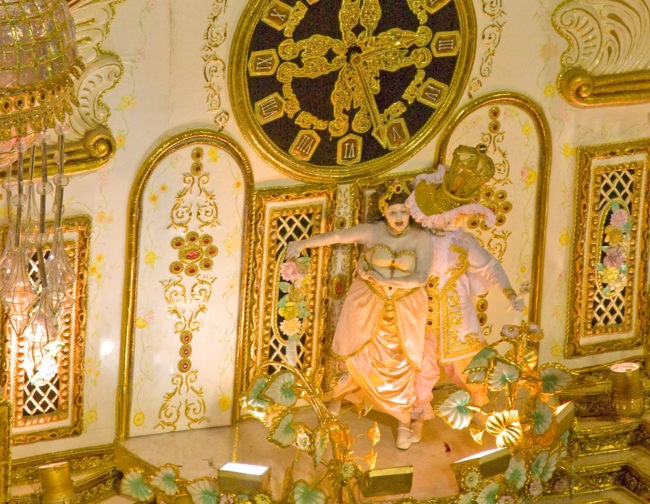
 And we know M’Lady will love a delicious stew. But WAIT! What are these bugs? They’re eating HRH’s veggies? What shall we do? Call an exterminator! An exterminator who makes his poisons from herbs indigenous to the Amazon, that’s who!
And we know M’Lady will love a delicious stew. But WAIT! What are these bugs? They’re eating HRH’s veggies? What shall we do? Call an exterminator! An exterminator who makes his poisons from herbs indigenous to the Amazon, that’s who! What’s with the trees, I wonder. Could this be the natural ingredient in a pesticide that’s safe and wonderful? I don’t know. These trees are marked with yellow ribbons like they were to be cut (or not cut). Did cutting these trees bring on the bugs? It’s such a mystery. Note that there are people on stilts inside. Sorry to ruin it for you if you thought they were real.
What’s with the trees, I wonder. Could this be the natural ingredient in a pesticide that’s safe and wonderful? I don’t know. These trees are marked with yellow ribbons like they were to be cut (or not cut). Did cutting these trees bring on the bugs? It’s such a mystery. Note that there are people on stilts inside. Sorry to ruin it for you if you thought they were real.

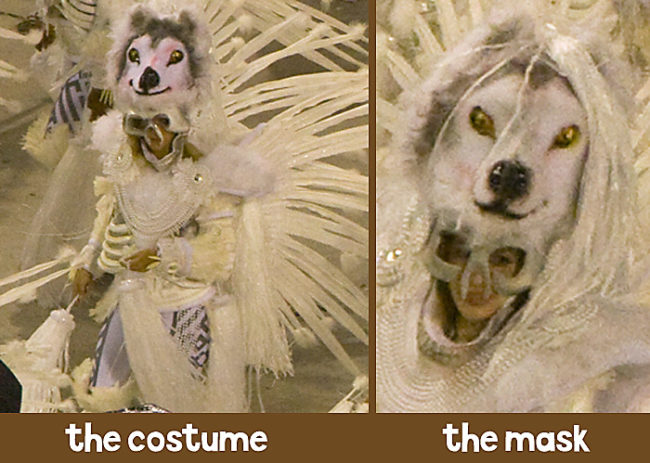

 The twirling group that followed was stellar. The skirts undulated with the turns, and it became a blinding mass of red, orange, yellow and brown punctuated with flashes of white that would appear when the skirt would catch air and fly up.
The twirling group that followed was stellar. The skirts undulated with the turns, and it became a blinding mass of red, orange, yellow and brown punctuated with flashes of white that would appear when the skirt would catch air and fly up.





 Right on her heels were a bunch of parrots that seem to have swallowed the humans that brought them to the parade.
Right on her heels were a bunch of parrots that seem to have swallowed the humans that brought them to the parade. This had begun to feel like a trek into the Amazon–a journey to find the gas deposits. But the dangers are plenty. The next float was led by an army of only about one millionth of the things that can kill a person in the jungle. It was headed up by a giant leering snake that swayed back and forth as if he were looking for just the right thing to bite. NOT ME!! And NOT ROBO!! We’re both scared shitless of snakes. Since childhood.
This had begun to feel like a trek into the Amazon–a journey to find the gas deposits. But the dangers are plenty. The next float was led by an army of only about one millionth of the things that can kill a person in the jungle. It was headed up by a giant leering snake that swayed back and forth as if he were looking for just the right thing to bite. NOT ME!! And NOT ROBO!! We’re both scared shitless of snakes. Since childhood.


 It was another case of people gyrating inside of globes. It was very ethereal, the way the wispy costumes would shimmer and flutter. They looked like mothmen.
It was another case of people gyrating inside of globes. It was very ethereal, the way the wispy costumes would shimmer and flutter. They looked like mothmen.

 This lineup of beauties heralded the arrival of energy itself: the dancing guy.
This lineup of beauties heralded the arrival of energy itself: the dancing guy.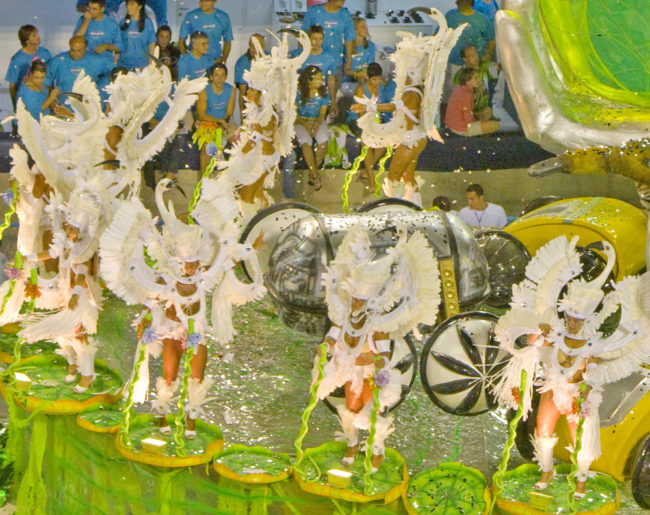 This young man was phenomenal. He was in constant motion from the time he came into view until the time he left it. Tap dancing 16th-notes fast, he personified perpetual motion, and the crowd went apeshit for him. Us too.
This young man was phenomenal. He was in constant motion from the time he came into view until the time he left it. Tap dancing 16th-notes fast, he personified perpetual motion, and the crowd went apeshit for him. Us too.


 We said our goodbyes, passed out belezas and obrigados, and began making our way out of the Sambódromo. We figured we’d miss most of the crowd not staying till the end, and were pretty much right. Only the outer areas were glutted with half-costumed participants again, sweating, beaming, drinking, shouting, dancing, singing, and glowing with satisfaction.
We said our goodbyes, passed out belezas and obrigados, and began making our way out of the Sambódromo. We figured we’d miss most of the crowd not staying till the end, and were pretty much right. Only the outer areas were glutted with half-costumed participants again, sweating, beaming, drinking, shouting, dancing, singing, and glowing with satisfaction. I must say, that’s a very unenthusiastic expression. If I didn’t know better, I’d swear that she wasn’t thrilled about me taking her picture. I don’t know what she was worried about. She always looks good. I, on the other hand, felt like I had been electrocuted the night before, then put in wet cement to sleep. People like me, we’re the photographers.
I must say, that’s a very unenthusiastic expression. If I didn’t know better, I’d swear that she wasn’t thrilled about me taking her picture. I don’t know what she was worried about. She always looks good. I, on the other hand, felt like I had been electrocuted the night before, then put in wet cement to sleep. People like me, we’re the photographers.
 Ain’t nothing like a little graffiti on a mid-18th-century historic treasure is there? Sigh.
Ain’t nothing like a little graffiti on a mid-18th-century historic treasure is there? Sigh. Or making pretty pictures.
Or making pretty pictures.
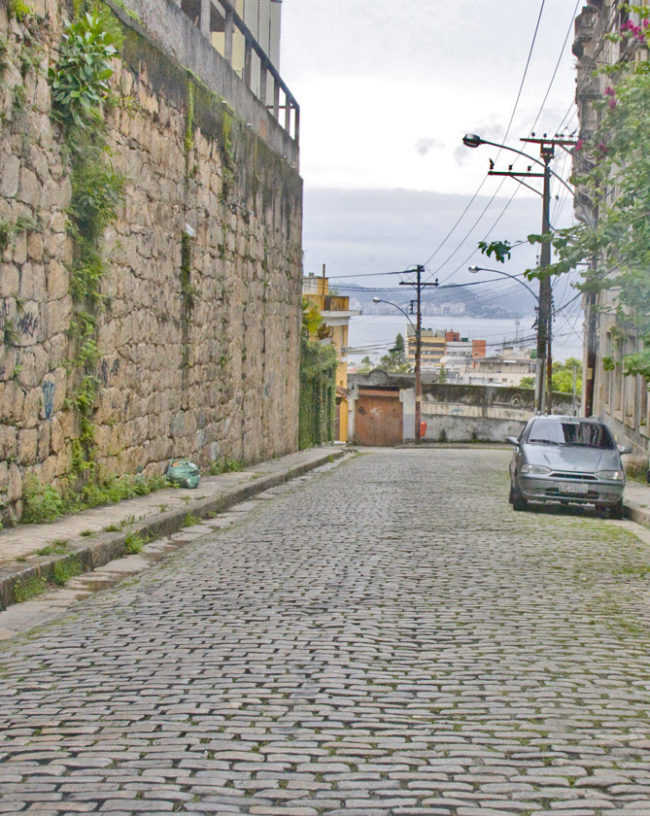 And just like in America, in recent years, Santa Teresa has been brought back to life in a laid back way as a home to artists and performers, who understand the value of being surrounded by both natural and man-made beauty. I’m sure the real estate is pricey now, but I’ll bet during the early days of the revival, you could have had yourself one of those incredible homes for nothing. I’m gonna go out on a limb and guess that in 1975, $10 to $25,000 American would have bought you some of the finest stuff on the hill. And it was fine.
And just like in America, in recent years, Santa Teresa has been brought back to life in a laid back way as a home to artists and performers, who understand the value of being surrounded by both natural and man-made beauty. I’m sure the real estate is pricey now, but I’ll bet during the early days of the revival, you could have had yourself one of those incredible homes for nothing. I’m gonna go out on a limb and guess that in 1975, $10 to $25,000 American would have bought you some of the finest stuff on the hill. And it was fine. At what seemed to be the summit, but wasn’t by any means, we found a small street party going on in an intersection. We decided to park and check it out. The cop in the above picture was friendly, and there to assure everyone they would have a safe experience. At least that’s what he looks like.
At what seemed to be the summit, but wasn’t by any means, we found a small street party going on in an intersection. We decided to park and check it out. The cop in the above picture was friendly, and there to assure everyone they would have a safe experience. At least that’s what he looks like. Daniel and Patricia had, of course, just flown in from Salvador (and BOY were their arms tired!), and they were about as fresh as we were, having been stimulated to death the night before at Carnaval. But Daniel can eat at the drop of a hat, and everybody enjoyed the baked cheese skewers that somebody was selling.
Daniel and Patricia had, of course, just flown in from Salvador (and BOY were their arms tired!), and they were about as fresh as we were, having been stimulated to death the night before at Carnaval. But Daniel can eat at the drop of a hat, and everybody enjoyed the baked cheese skewers that somebody was selling. We took in all the participants at the gathering. Looked like a melange of cool people with fun on the brain. Nothing huge, just fun. Some kind of music and rhythm going on at the core. I noticed a bunch of little throw-on costumes that lent a real down-home tone to the whole thing. Everybody I held the camera up to responded with the secret sign and a smile.
We took in all the participants at the gathering. Looked like a melange of cool people with fun on the brain. Nothing huge, just fun. Some kind of music and rhythm going on at the core. I noticed a bunch of little throw-on costumes that lent a real down-home tone to the whole thing. Everybody I held the camera up to responded with the secret sign and a smile.

 I noticed a bunch of costumettes that seemed to be derived from Carnaval outfits. I would like to know exactly how much of the costume you get to keep.
I noticed a bunch of costumettes that seemed to be derived from Carnaval outfits. I would like to know exactly how much of the costume you get to keep.




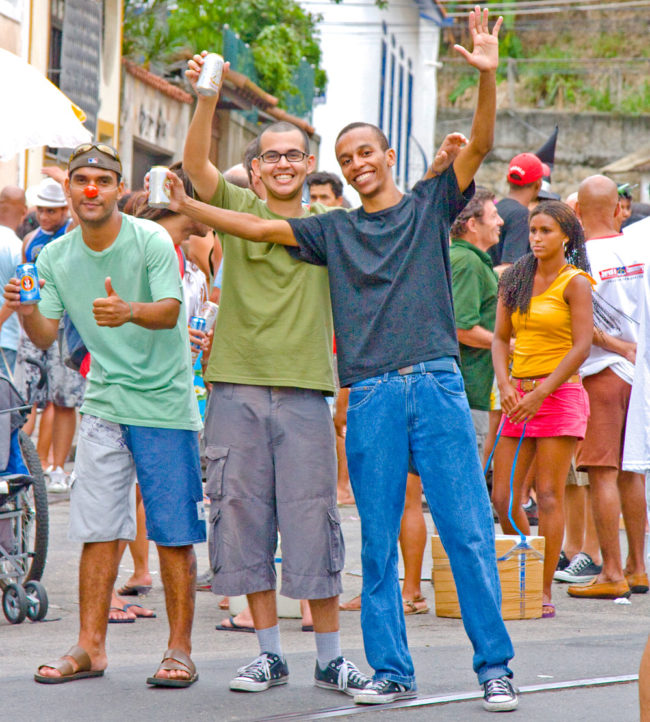 and charming Brazilian girls
and charming Brazilian girls “Let’s go,” everybody said.
“Let’s go,” everybody said. As we wound down, we encountered more people in larger spaces, but they were all in accommodation mode.
As we wound down, we encountered more people in larger spaces, but they were all in accommodation mode.




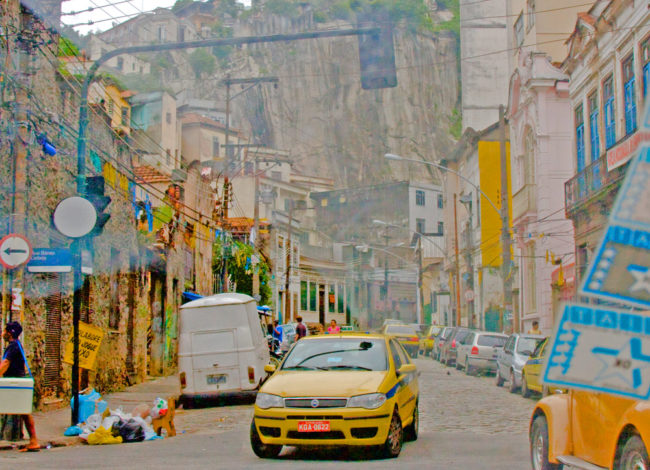
 When we pulled up in the parking lot, there was a line that stretched down the steps to the ticket booths and around the perimeter. It looked long at first, but seemed to be moving fairly rapidly. What else were we gonna do? Ride around looking for something that had a shorter line? I don’t think so. We decided to gut it out.
When we pulled up in the parking lot, there was a line that stretched down the steps to the ticket booths and around the perimeter. It looked long at first, but seemed to be moving fairly rapidly. What else were we gonna do? Ride around looking for something that had a shorter line? I don’t think so. We decided to gut it out. “I’ll meet y’all at the end of the line,” I hollered at them, noticing that Robo was coming up behind me. Inside the building I was met with various wall displays and a diorama of Rio, the bay and the various mountains that rise from it. There was a tiny little cable car mounting a tiny little Sugarloaf. Neat. There was also a gift shop, but it became a blur as I dashed past and up the stairs as fast as one like me can dash. Robo must have ridden my draft, because we appeared at the door to the sanitário simultaneously, and almost did a Three Stooges trying to get through it together.
“I’ll meet y’all at the end of the line,” I hollered at them, noticing that Robo was coming up behind me. Inside the building I was met with various wall displays and a diorama of Rio, the bay and the various mountains that rise from it. There was a tiny little cable car mounting a tiny little Sugarloaf. Neat. There was also a gift shop, but it became a blur as I dashed past and up the stairs as fast as one like me can dash. Robo must have ridden my draft, because we appeared at the door to the sanitário simultaneously, and almost did a Three Stooges trying to get through it together. We marveled at the people scaling the mountain behind the ticket booth. They were at least 100 feet in the air, clinging onto the face of the rock, looking like flies on a dark wall: hard to find at first. Watching them up there caused every orifice on my body to slam shut in fear. But I could hardly look away.
We marveled at the people scaling the mountain behind the ticket booth. They were at least 100 feet in the air, clinging onto the face of the rock, looking like flies on a dark wall: hard to find at first. Watching them up there caused every orifice on my body to slam shut in fear. But I could hardly look away. On the first level, there were benches everywhere, and people were lounging around like it was a park or something. I took a shot of the group, then Robo took one of Jean and me.
On the first level, there were benches everywhere, and people were lounging around like it was a park or something. I took a shot of the group, then Robo took one of Jean and me.
 It’s totally amazing how much Jean looks like her mother.
It’s totally amazing how much Jean looks like her mother.

 In this closeup, it looks like Robo is pissed off about something. This could be the point in the trip where his sinuses began to revolt against him. The altitude may have been punching him in the forehead.
In this closeup, it looks like Robo is pissed off about something. This could be the point in the trip where his sinuses began to revolt against him. The altitude may have been punching him in the forehead. Once we had alighted the car, we were instantly hit with the unobstructed panorama that Sugarloaf affords. These shots of the harbor were very cool. Notice how the orange roofs of the chi-chi enclave below echo the favelas. Both ends of the money spectrum with similar visual impact. EYE ROW KNEE!
Once we had alighted the car, we were instantly hit with the unobstructed panorama that Sugarloaf affords. These shots of the harbor were very cool. Notice how the orange roofs of the chi-chi enclave below echo the favelas. Both ends of the money spectrum with similar visual impact. EYE ROW KNEE!
 By this time, Daniel was hungry again. The grant included snacks, too! Robo handed him a bunch of Reais, and we walked up to the booth to order. I got a couple of agua com gaís (sparkling water), and then discovered that they had those cheese roll things! Daniel ordered that and a Coke. We all sat around, Daniel politely sharing his food, the rest of us like a bunch of dive bombers into the little paper tray. I chugged that agua com gaís pretty fast, then decided to go take another picture of The Christ ruling over Rio.
By this time, Daniel was hungry again. The grant included snacks, too! Robo handed him a bunch of Reais, and we walked up to the booth to order. I got a couple of agua com gaís (sparkling water), and then discovered that they had those cheese roll things! Daniel ordered that and a Coke. We all sat around, Daniel politely sharing his food, the rest of us like a bunch of dive bombers into the little paper tray. I chugged that agua com gaís pretty fast, then decided to go take another picture of The Christ ruling over Rio. I also spent time taking pictures of other people with their cameras. There were a bunch of Australians there, and I did shots of 3 different Aussie couples.
I also spent time taking pictures of other people with their cameras. There were a bunch of Australians there, and I did shots of 3 different Aussie couples. We made the car without any trouble. But there was a counter that told how many could get on, and it was ticking madly toward the limit. And a few extra I noted, to my chagrin.
We made the car without any trouble. But there was a counter that told how many could get on, and it was ticking madly toward the limit. And a few extra I noted, to my chagrin. It turns out that the guy was here in Brazil on kind of an exploration trip. He had been to Argentina looking to buy property to set up a winery/fine restaurant/lodge and hunting deal for executives and jet setters. Being from the South, he was completely familiar with the hunting part. Having money, which he obviously did, would give him an edge with clientele.
It turns out that the guy was here in Brazil on kind of an exploration trip. He had been to Argentina looking to buy property to set up a winery/fine restaurant/lodge and hunting deal for executives and jet setters. Being from the South, he was completely familiar with the hunting part. Having money, which he obviously did, would give him an edge with clientele. None of us passed up the bathroom when we landed, and I got a chance to see a little more of what was in the gift shop. I’ll be switched if there weren’t several statues of Iemanjá on the shelf! I could tell because she was admiring herself in the mirror, and there were shells all around her. But only one who had felt her hot breath on his neck would recognize her with such clarity.
None of us passed up the bathroom when we landed, and I got a chance to see a little more of what was in the gift shop. I’ll be switched if there weren’t several statues of Iemanjá on the shelf! I could tell because she was admiring herself in the mirror, and there were shells all around her. But only one who had felt her hot breath on his neck would recognize her with such clarity. Jean loves having that ole picture made, doesn’t she?
Jean loves having that ole picture made, doesn’t she? Look at that noble face! A native Niteróian, just like Sergio Mendes! What’s not to love? Right in the middle of my waxing philosophic about Marcelo and his importance, he interrupted with “What about my image rights for the picture? Are you going to pay me image rights?” I responded with a big laugh, and then another picture. This time Daniel sniffed out the camera, joining the exclusive club that Robo and I are members of.
Look at that noble face! A native Niteróian, just like Sergio Mendes! What’s not to love? Right in the middle of my waxing philosophic about Marcelo and his importance, he interrupted with “What about my image rights for the picture? Are you going to pay me image rights?” I responded with a big laugh, and then another picture. This time Daniel sniffed out the camera, joining the exclusive club that Robo and I are members of. Looks like one of them gol-durned Jonas Brothers, doesn’t he? If he didn’t have that zit, he could be a star.
Looks like one of them gol-durned Jonas Brothers, doesn’t he? If he didn’t have that zit, he could be a star. Despite the mass of food, we all decided to share a dessert. And managed to eat it all.
Despite the mass of food, we all decided to share a dessert. And managed to eat it all. We headed out, all about to bust. I obrigado’ed the shit out of everybody, and so did Jean. “It’s obrigadA,” I told her on the way out. “You said obrigadO.”
We headed out, all about to bust. I obrigado’ed the shit out of everybody, and so did Jean. “It’s obrigadA,” I told her on the way out. “You said obrigadO.” And then, just to make sure I wasn’t a total idiot about my hatred of flash, one with the flash.
And then, just to make sure I wasn’t a total idiot about my hatred of flash, one with the flash. The valet pulled up with Marcelo’s car, and we all wedged ourselves in and headed home, which was by now a familiar thing.
The valet pulled up with Marcelo’s car, and we all wedged ourselves in and headed home, which was by now a familiar thing.